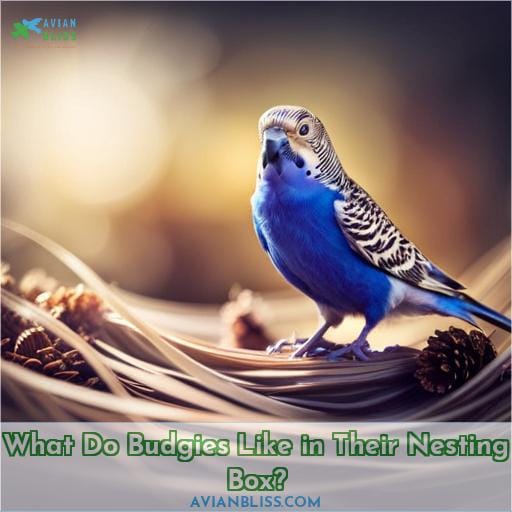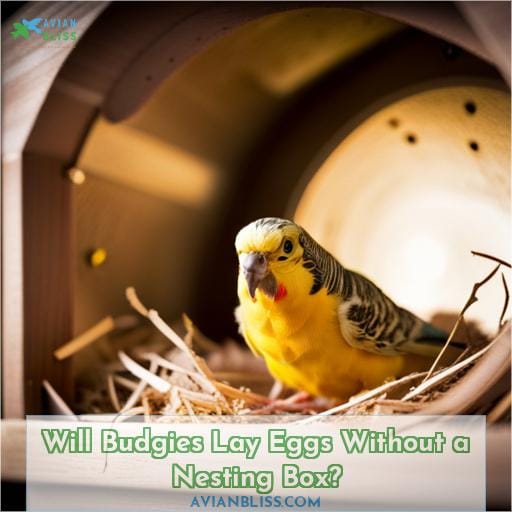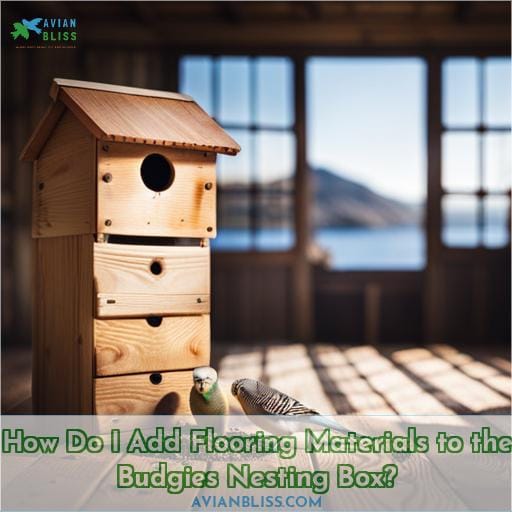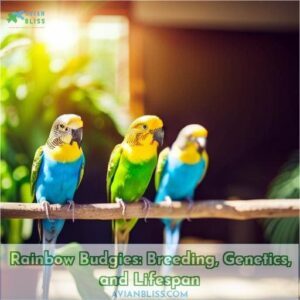This site is supported by our readers. We may earn a commission, at no cost to you, if you purchase through links.
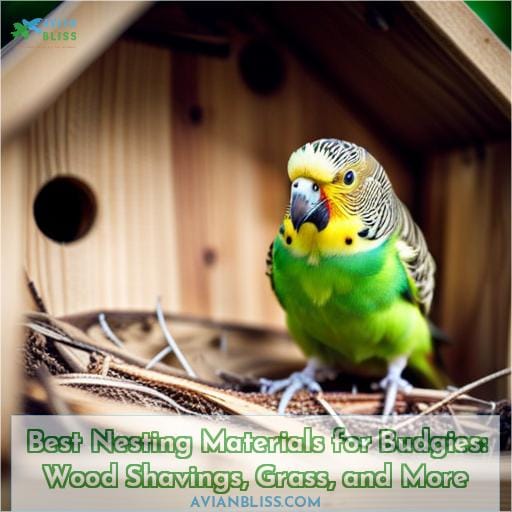 Imagine providing the perfect nesting materials for your budgies, creating a cozy and safe environment where they can lay their eggs.
Imagine providing the perfect nesting materials for your budgies, creating a cozy and safe environment where they can lay their eggs.
In this article, we’ll explore the top choices for budgie nesting materials: wood shavings, grasses, and more. Discover why these materials are preferred by experts in avian care and how they contribute to the well-being of your feathered friends.
Get ready to create a nest that will make your budgies feel right at home!
Table Of Contents
- Key Takeaways
- What Do Budgies Like in Their Nesting Box?
- What is the Best Material for Budgie Nesting?
- Will Budgies Lay Eggs Without a Nesting Box?
- When Should I Put a Nesting Box for Budgies?
- How Do I Add Flooring Materials to the Budgies Nesting Box?
- What Should I Avoid Putting in a Nesting Box?
- Frequently Asked Questions (FAQs)
- Conclusion
Key Takeaways
- Enough space and a comfortable lining material are important for budgie nesting boxes.
- The nesting box should provide a dark and private environment for the budgies.
- Cleanliness and a warm, humid environment are essential for the nesting box.
- Good materials for budgie nesting include wood shavings, dried grass, shredded paper, and twigs.
What Do Budgies Like in Their Nesting Box?
When it comes to their nesting box, budgies have specific preferences.
First and foremost, they need enough space to move comfortably but not excessively large that warmth is compromised.
Additionally, a comfortable lining material such as dry grass or feathers provides insulation and promotes breeding behavior.
Budgies also require a dark environment for privacy during the breeding process while cleanliness ensures a healthy environment for both parents and chicks.
Lastly, maintaining a warm and humid environment is crucial for successful hatching of eggs.
Enough Space
Budgies prefer nesting boxes that provide sufficient space for their comfort and breeding needs.
Avoid overcrowding the box, as budgies require enough room to move around comfortably.
Providing options for lining material allows them to choose what they prefer.
Placing a perch outside the nest gives them a place to rest while tending to their eggs or chicks.
Remember to clean the nesting box more frequently, maintaining cleanliness is essential for their health and well-being.
Comfortable Lining Material
To create a comfortable nesting environment for your budgies, it’s important to provide them with lining materials that they prefer and feel cozy on.
Offer options such as dry grass, shredded paper, or wood shavings for them to choose from. Budgies enjoy chewable materials that they can shred and arrange in their nests.
Ensure the bottom of the nesting box is slightly rounded to prevent eggs from rolling into corners and rough up the surface to avoid splay legs.
A Dark Environment
Ensure your budgies have a dark and private nesting box.
Limit light exposure through small entrance holes.
Enhance their sense of security while preventing diseases in this warm sanctuary by avoiding drafts with proper insulation measures like sealing any gaps or cracks near their nests’ vicinity.
Cleanliness
How can you ensure cleanliness in your budgie’s nesting box?
Regular cleaning is essential to prevent diseases and maintain a healthy environment for breeding.
Avoid moisture buildup by choosing materials that absorb well and promote airflow.
Provide options for the lining, such as dry grass or feathers, to enhance comfort.
Place a perch outside the box for easy access during nest building.
Introduce nesting materials after eggs have been laid and incubation has started.
Warm and Humid Environment
Maintaining a warm and humid environment is crucial for budgies to feel comfortable in their nesting box.
Place the nesting box away from drafty areas in a warm spot.
Monitor moisture and humidity levels, as proper levels aid chick leg development.
Consider the nesting box size and location in the cage to maintain optimal warmth.
Use nesting materials like wood shavings to help regulate temperature and humidity.
What is the Best Material for Budgie Nesting?
When considering the best materials for budgie nesting, there are several options to consider:
- Wood shavings and wood pellets, such as untreated varieties, can effectively absorb moisture but require regular cleaning.
- Dried grass, dead leaves, and twigs provide a natural environment while ensuring dryness and freedom from pathogens.
- Shredded paper offers soft bedding that traps heat for warmth but may need frequent replacement if exposed to moisture.
Each material has its pros and cons in terms of affordability, cleanliness, comfortability for the budgies’ breeding behavior.
Wood Shavings and Wood Pellets
To provide the best nesting materials for your budgies, consider using wood shavings and wood pellets.
These materials are ideal for creating a suitable nesting environment as they absorb moisture effectively, preventing splay leg in chicks. They also promote nesting behavior insights and contribute to the overall success of breeding.
Additionally, dried grass and dead leaves can be added to enhance comfort and mimic natural conditions in the wild.
Dried Grass, Dead Leaves, and Twigs
When considering the best materials for budgie nesting, dried grass, dead leaves, and twigs are a natural and preferred option.
These materials create a natural nesting environment that mimics their wild habitat. Additionally, they provide opportunities for budgies to exhibit breeding behaviors such as chewing and arranging materials.
For optimal chick development, ensure the nest box has a slight rounded bottom to prevent eggs from rolling into corners.
Consider timing considerations when introducing these materials to avoid rejection by budgies during critical nesting stages.
Shredded Paper
Using shredded paper as nesting material is an excellent choice for budgie breeding.
Shredded paper is soft, absorbs moisture effectively, and traps heat to provide warmth for the eggs and chicks. Additionally, it’s easily replaceable when soiled or damaged by moisture exposure.
Ensure that the shredded paper you use doesn’t contain any toxic ink or chemicals to maintain a safe environment for your budgies.
Will Budgies Lay Eggs Without a Nesting Box?
Now that we’ve explored the best materials for budgie nesting, let’s address an important question: Will budgies lay eggs without a nesting box?
While it’s possible for budgies to lay eggs without a specific nest in captivity, providing them with a suitable nesting box greatly increases their chances of successful breeding. Budgies have a natural instinct to seek out cavities or hollows for mating and laying eggs.
Without a designated space, they may become stressed and exhibit abnormal behaviors.
A well-prepared nest box not only provides comfort and security but also protects the eggs from damage and maintains optimal conditions for incubation. Additionally, appropriate nesting material options are crucial as they promote breeding behavior and contribute to chicks’ leg development by mimicking natural conditions in the wild.
So while it isn’t mandatory, introducing proper timing considerations when incorporating nesting materials can significantly enhance your budgie’s reproductive experience.
When Should I Put a Nesting Box for Budgies?
To ensure optimal breeding conditions for your budgies, it’s important to introduce a nesting box when they reach adulthood, typically around two years old.
Budgie breeding age varies slightly among individuals, but waiting until they’re mature ensures that they’ve reached sexual maturity and are physically ready for the demands of reproduction. The timing also aligns with the natural budgie breeding season, which occurs during wet spring and summer periods in the wild.
By providing a nesting box at this stage, you create an environment that encourages their natural instincts to breed and raise chicks.
Additionally, make sure to provide a balanced diet rich in nutrients essential for successful reproduction such as protein-rich foods like egg food alongside their standard feed.
Remember to also provide spacious cages or compartments within an aviary specifically designed for budgie breeding so that each pair has adequate personal space during this crucial period of their lives.
How Do I Add Flooring Materials to the Budgies Nesting Box?
Add the flooring materials to your budgie’s nesting box by layering them on the dry floor area.
- Gradually introduce unscented pine shavings once eggs are laid. Sneak them in to avoid rejection.
- Rough up the nest box bottom with a Dremel tool to prevent eggs from rolling.
- Use pine shavings until chicks hatch, then remove to prevent slipping.
- Consider shredded paper or wood shavings. Add gradually to allow acceptance.
The key is to slowly acclimate your budgie to new materials. Be mindful of timing and material safety. With patience and the proper substrate, you can create an ideal nesting environment.
What Should I Avoid Putting in a Nesting Box?
You should avoid using any toxic materials, foodstuffs that may rot, or chemically treated materials in your budgie’s nesting box.
Materials like plastics, rubber, cleaning solutions, perishable foods, or wood shavings treated with chemicals could be hazardous to your budgies.
Focus instead on providing untreated, natural materials that will keep the nest clean, dry, and safe.
Toxic Materials
Your budgie’s health can be seriously harmed by exposing them to toxic materials in their nesting box.
Avoid using mothballs, as they release harmful fumes that can cause respiratory problems for your bird.
Incense and essential oils should also be avoided, as they can irritate the skin and respiratory system of your budgie.
Additionally, bleach is highly corrosive and can cause burns if it comes into contact with your bird’s sensitive skin or feathers.
Lastly, cedar chips shouldn’t be used in the nesting box as they may also lead to respiratory problems for budgies.
Foodstuffs and Water
Avoid placing any foodstuffs or water inside the budgie nesting box, as it can lead to contamination and potential health risks for both the breeding pair and their chicks.
- Mold
- Mildew
- Bacteria
Food and water can promote the growth of harmful microorganisms like mold, mildew, and bacteria. These can lead to illness through rot and damp conditions in the enclosed space of the nesting box.
Treated Materials
You shouldn’t put treated materials in a budgie’s nesting box because they could be toxic or irritating to the birds.
Opt for natural, untreated options to avoid chemicals that may be absorbed through eggshells or damage delicate chick respiratory systems.
Even subtle fumes could trigger nesting box rejection, interfering with natural instincts for preparing a safe nesting environment.
Prioritize your budgie’s health by selecting unscented, chemical-free nesting materials.
Frequently Asked Questions (FAQs)
Why do budgies reject nesting material?
Budgies may reject nesting material due to their natural instincts influenced by wild flock behavior. This rejection serves as a disease prevention mechanism, mimicking the budgies’ habit of reusing nests in the wild.
What are some good nesting materials for budgies?
To create a cozy nest for your budgies, opt for:
- Soft, untreated wood shavings
- Shredded paper
These materials will provide warmth and security, allowing your feathered friends to feel right at home.
How do I ensure chick development with nesting material?
To ensure optimal chick development, provide nesting material that mimics natural conditions in the wild.
Opt for materials that promote leg strength and prevent slipping or splay legs, such as untreated wood shavings or shredded paper.
What should I consider when timing the introduction of nesting material?
To ensure optimal chick development, timing is crucial when introducing nesting material for your budgies.
Gradually introduce materials after eggs are laid and incubation has begun to avoid rejection by the budgie.
Observe nesting behavior for informed adjustments.
What materials should I avoid putting in a nesting box?
To ensure the safety and well-being of your budgie during breeding, avoid using materials such as:
- Cedar shavings
- scented pine
These can be harmful to their respiratory system and may cause health issues for both the parents and chicks.
Conclusion
To create a cozy and safe nesting environment for your budgies, it’s important to choose the right materials.
- Wood shavings, grass, and shredded paper are all excellent options for lining the nesting box.
- These materials provide comfort, insulation, and a natural feel for your feathered friends.
- Avoid using toxic or treated materials, and remember to keep the nesting box clean and warm.
By providing the best nesting materials, you’ll ensure that your budgies feel right at home and have a comfortable space to lay their eggs.

